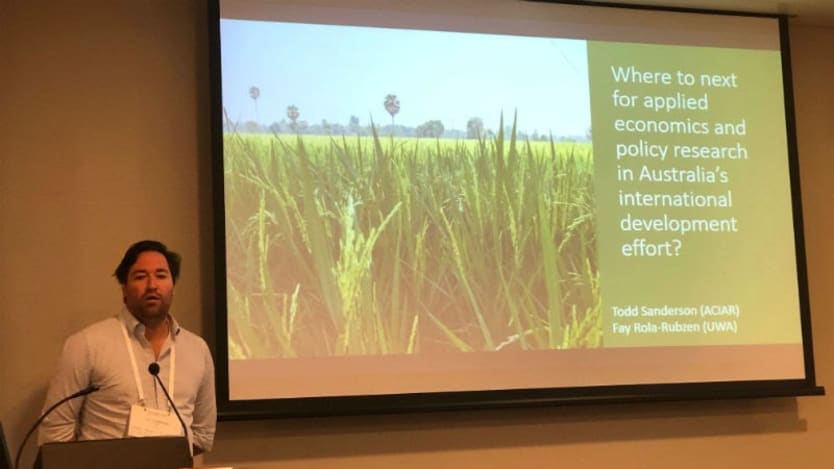
CANBERRA — The future of research supported by the Australian Center for International Agricultural Research will be cross-cutting and system-focused to deliver sustainable impacts and lasting solutions. But this requires a change in existing practices, which research partners are being educated on.
At the Australian Agricultural & Resource Economics Society 2020 conference in Perth on Feb. 13, ACIAR co-convened a mini-symposium to engage the research community on the direction of applied economics and policy research in Australia’s international development program.
“I think it is important for ACIAR to send a message to these groups, who are essentially our research partners, to ensure they recognize that we are thinking about the future in a way that does not necessarily look like the past,” Todd Sanderson, economics and policy program manager for ACIAR, told Devex.
“It’s not just about boosting productivity or crops — it’s about boosting or tackling behavior to get stakeholders engaged with new processes or practices.”
— Todd Sanderson, economics and policy program manager, ACIARThe release in 2018 of a new strategic direction for ACIAR outlined six core areas of focus, including climate, water, gender, nutrition, and food security. But to tackle these challenges effectively and sustainably, the composition of ACIAR’s research portfolio is set to evolve to demand new approaches, capabilities, and ideas that can cut across the areas of focus. Increasing the involvement of the applied economics and policy research community is Sanderson’s focus.
“There is a sense in the research and economics community that ACIAR is a pretty conservative organization and it can be hard to get novel research supported by ACIAR,” Sanderson said.
“But we recognize that the global research for development environment is changing pretty quickly, and there is a need for us to throw some questions out there in terms of how it is evolving and where economics and policy can make contributions to these existing and emerging challenges,” he said.
New approaches to research questions
ACIAR believes economics and policy can cross-cut the key focal areas to help deliver greater impact. But introducing this thinking to programs requires partners to shift the research questions they are asking.
“Previously, a research proposal might be about crop breeding, breeding for high yield or tolerance, and there might be an economist who comments at the end of the financial impact of adopting a new variety,” Sanderson said. “But we can’t just tackle increased production — we need to understand it is part of broader market systems.”
To elevate research questions, Sanderson is encouraging partners to ask how their work would fit into the social, economic, and cultural system and impact vulnerable groups. By asking these early on, ACIAR believes it would get the right stakeholders at the table, and projects would achieve better outcomes.
“We quite often talk these days about systems-level thinking when it comes to tackling these challenges,” Sanderson explained. “So it’s not just about boosting productivity or crops — it’s about boosting or tackling behavior to get stakeholders engaged with new processes or practices. Thinking about these problems from a systems-level perspective is where I think the state of the arts science and technology has moved into.”
But it is also an approach that is critical for ensuring research is fit for purpose.
“As we have seen many, many times, if local partners aren’t on board there will be no regulatory system to support a solution, and the market system will not recognize the value of new plant varieties, for example.”
Bringing social sciences into the project is equally as important, Sanderson said, to better understand the players in complex systems and their various needs.
“We need to ask what those stakeholders want for their country,” he said. “We can get it wrong if we’re just making assumptions.”
Supporting a research transition
As part of the AARES symposium, Sanderson asked researchers to think critically about their involvement with research over recent years and what success has looked like — and also to recognize what failures look like. With this in mind, he asked them to consider how applied economics and policy could have contributed to better understanding the systems and delivering better outcomes — and provided thoughts on how they can shape their thinking.
“The simplest advice is to start off thinking broadly about the nature of the systems they are engaging in,” he said. “When I am talking to research partners, I try to impress that we should be thinking about where other relevant social sciences belong to help us frame the systems. This helps to think about how primary research questions are asked in the first place.”
Engaging in this way is one of the steps being taken to educate partners on what is expected of them when engaging with ACIAR, but Sanderson said the shift within ACIAR would be iterative and come with support.
“Whilst we are concerned about realizing positive economic and policy impact, we do have an iterative process with project proponents and we engage in co-designs,” he said. “Research program managers from ACIAR negotiate back and forth to help create the best designed projects that support the needs of these complex systems.”








